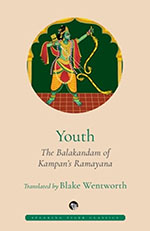Though Kamban’s iRamavataram is considered the greatest poetic work of the Tamil language and has served as a source for numerous retellings into English, including C Rajagopalachari’s, Wentworth’s translation of the first canto, the Balakanda is probably the first proper ‘translation’ of even a part of it. The introduction sets the stage, as it were, for the translation itself to unfold. Unlike the Valmiki Ramayana, which is composed in a single metre, the shloka, said to be named thus as it was born out of shoka, grief, when Valmiki witnessed a hunter kill one of a pair of mating cranes, Kampan’s Tamil masterpiece has no less than eighty-seven varieties of metres which are employed to create varied effects. Composed most probably in the twelfth century, when the epic tale was certainly very well-known, the iRamavataram makes it ‘Tamil’ in ways beyond the linguistic by drawing on the long Tamil poetic tradition, bhakti devotionalism, Puranic mythology, and local traditions.
Wentworth’s introduction shows how Kampan locates the epic in a Tamil environment through analogies and metaphors and an appeal to the Sangam tradition of evoking certain emotions through specific ecospheres (tinai). Even more crucially, he shows how the tensions of love and devotion of the Tamil literary sphere are played out in the text. The rakshasas are not uniformly evil in Kampan’s telling. For instance, Surpanakha, an entirely irredeemable character in the Valmiki version, experiences the agony of lovesickness which Rama and Sita too had experienced, having caught each other’s eyes accidentally the day before their wedding, not knowing that they would be joined in matrimony the next day. Ravana himself is complex—not merely monstrous.
Continue reading this review

